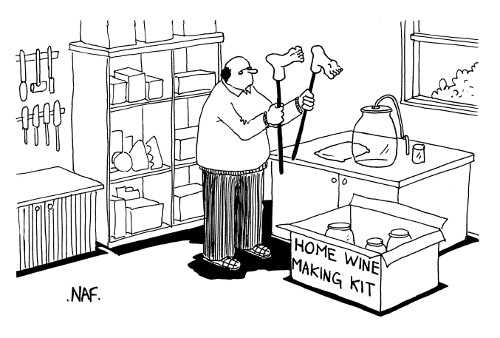Well it is much easier than you might think. Ten years ago I would never have thought that it is possible to make wine yourself. That was a mistake. It is really easy and you don’t need a lot of materials. If you are a beer maker you have almost everything already and most of these steps are familiar to you.
I will try to write a general procedure for making wine and explain the steps and equipment in other stories.
First you need to decide what kind of wine you want to make; Do you have fresh fruit available or do you want to make it from store bought juices?
- If you have fresh fruit you are limited by the fruit. It is not possible to make red wine from apples.
- Serious wine makers will curse, but it is very easy to make pretty good wine from juices from the supermarket. And you have much more choices the whole year.
Once you have decided on the fruit there are some other choices;
- How much alcohol do you think is appropriate for your wine? White wines have less alcohol than red wines in general.
- How much acid do you want to use? White wines have a little more acid than red wines in general.
- Do you want a wine with a lot of body or a lighter wine? White wines have less body in general.
- Do you want to add tannin to your wine? In white wines I think it usually should not be used but in red wines it can give some nice detail to it. Definitely do not use too much.
- Do you want a taste of wood or something else?
Ok. Let’s begin.
Let’s say you want to make 10 liters of a very basic apple wine from supermarket juice, with 11% alcohol, and acidity of 6 gm/l.
- You can make this wine from cheap apple juice made from concentrate but if you don’t mind spending a little more you can also try to find fresh apple juice. Check on the package that there are no preservatives in the juice.
- Measure the specific gravity with a hydrometer. If you don’t have one you can check on the package how much sugar is in the juice. This could be around 110 gm/l.
To make a wine with 11% alcohol you need approximately 200 gm/l of sugar. So per liter you need to add 90 gm. - If you have an acid test set you can measure how much acid is in the juice. Measure it and make a note. Let’s say the test says 4 gm/l.
To make the acidity 6 gm/l you need to add 2 gm/l acid. I would suggest citric acid for this wine.
Let’s make wine!
- Work clean! Sterilize all your equipment, and your hands with a sulphite solution.
- Add 900 gm sugar and 20 gm acid to a fermenting bucket.
- Fill the bucket up to 10 liter with the apple juice.
- Stir until the sugar is dissolved.
- Add the yeast to a small glass of water. Use a good yeast. It can make or break your wine.
- After 15 minutes add the yeast to the bucket.
- Close the lid of the bucket and place the airlock.
- Write down what you did! If you make a great wine you need your notes to create it again. Trust me; you will not remember later!
That’s it! You are making wine! Or better; your yeast is converting the sugar into alcohol.
- The airlock should start bubbling in a few hours and some foam will form.
- When the first stage is over and there are not so many bubbles coming out of the airlock I rack the future wine in a demijohn, leaving most of the lees in the bucket. In this stage you don’t want air touching the wine so the demijohn should be filled up to the neck!
- Leave the wine to clear. This can take a long time. Some wines will never be completely clear.
- Have patience. Months of patience.
- When you think it is ready, rack the wine in the fermenting bucket or another demijohn with a little dissolved sulphite. Try not to disturb the lees in the demijohn.
- Rack the wine in bottles and seal them with a cork or a crown cap.
And you are finished. You have wine in bottles. Wait for a few weeks before you open them because they might suffer from something called bottle shock.
Believe it or not but it can be this simple and you will be surprised about the wines you will produce. And another big advantage of using juices from a supermarket is that you can make wine throughout the year. You will learn much quicker than somebody who can make wine only when he has fruit.
This short story describes how to make wine but I left out a lot of small things that I also would like to explain. I will do that in other stories using this one as a general guide line.
Cheers
Hans


